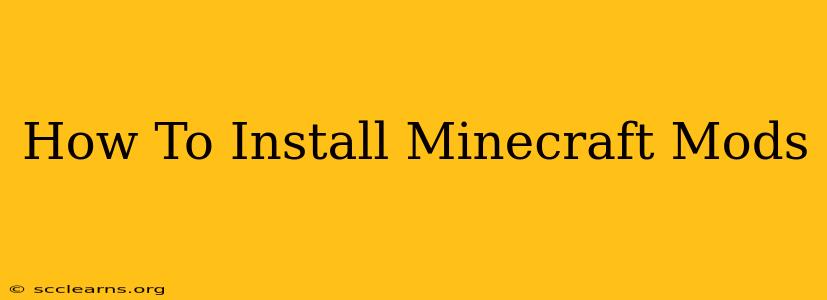So, you've decided to spice up your Minecraft experience with mods? Excellent choice! Mods can transform your gameplay, adding new dimensions, items, creatures, and even entire game mechanics. But before you can start exploring enchanted forests or battling robotic dragons, you need to know how to install them. This guide will walk you through the process, step-by-step, regardless of whether you're playing Java Edition or Bedrock Edition.
Understanding the Differences: Java vs. Bedrock
Before diving into the installation process, it's crucial to understand that installing mods for Java Edition (PC/Mac) is vastly different from installing add-ons (the Bedrock equivalent of mods) for Bedrock Edition (Windows 10, Xbox, PlayStation, Switch, Mobile). Let's break it down:
Java Edition Mods:
- Require Forge or Fabric: These are "mod loaders," essentially intermediary programs that allow Minecraft to run mods. You'll need to install one of these before you can install any mods.
- More complex installation: Involves downloading multiple files and placing them in specific folders.
- Wider variety of mods: Java Edition boasts a significantly larger and more diverse mod community.
Bedrock Edition Add-ons:
- Usually simpler installation: Add-ons are often installed directly through the Minecraft Marketplace or by placing files in specific folders.
- Fewer mods: While the Bedrock community is growing, it still has a smaller selection of add-ons compared to Java.
- No need for a separate mod loader: Bedrock handles add-on loading natively.
Installing Mods for Minecraft Java Edition
This process requires a bit more technical know-how. Here's a breakdown:
Step 1: Choose Your Mod Loader (Forge or Fabric)
Forge is the more established and widely used mod loader, offering excellent compatibility with a vast library of mods. Fabric is a newer, more lightweight option, often favored for its performance and simpler modding structure. Choose the loader that best suits your needs and the mods you plan to install. Many mods will specify which loader they require.
Step 2: Download and Install the Chosen Mod Loader
Download the appropriate installer for your Minecraft version from the official Forge or Fabric website. Run the installer, making sure to select the correct Minecraft version.
Step 3: Download Your Chosen Mods
Find the mods you want to use on reputable websites like CurseForge. Always download mods from trusted sources to avoid malware. Pay attention to the mod's description – it should specify the Minecraft version and the mod loader it requires (Forge or Fabric).
Step 4: Place Mods in the Correct Folder
Once downloaded, locate your Minecraft mods folder. The location varies slightly depending on your operating system, but it's usually found within your .minecraft folder. The exact path will be something like:
- Windows:
%APPDATA%\.minecraft\mods - macOS:
~/Library/Application Support/minecraft/mods
Simply drag and drop the downloaded mod files (usually .jar files) into this folder.
Step 5: Launch Minecraft and Enjoy!
Launch Minecraft, select the profile that corresponds to the version of Minecraft you installed the mods for, and select your mods. If everything is installed correctly, you should see the changes made by your mods in your game.
Installing Add-ons for Minecraft Bedrock Edition
Installing add-ons for Bedrock is considerably simpler:
Step 1: Through the Marketplace (Easiest Method)
Many add-ons are available directly through the Minecraft Marketplace. Simply browse the available content, purchase what you like, and they'll be automatically installed.
Step 2: Manual Installation (for Add-ons downloaded from other sources)
Some add-ons may be downloaded from external websites. These usually come as a .mcaddon file. Follow these steps:
- Locate your Add-ons folder: This location varies depending on your platform, but you can usually find it by searching for your "Minecraft Worlds" folder. The Add-ons folder will be inside.
- Copy and paste: Drag and drop the
.mcaddonfile into the Add-ons folder. - Launch Minecraft: The add-on should be available for use.
Troubleshooting Tips
- Incorrect Minecraft Version: Make sure you're using the correct Minecraft version for your mods/add-ons.
- Mod Conflicts: Conflicts between mods can cause crashes. Try disabling mods one by one to identify the culprit.
- Corrupted Files: Re-download any mods or add-ons that may be corrupted.
- Outdated Loaders: Make sure your mod loader is up-to-date.
By following these steps, you’ll be well on your way to customizing your Minecraft experience with mods and add-ons. Happy gaming!

